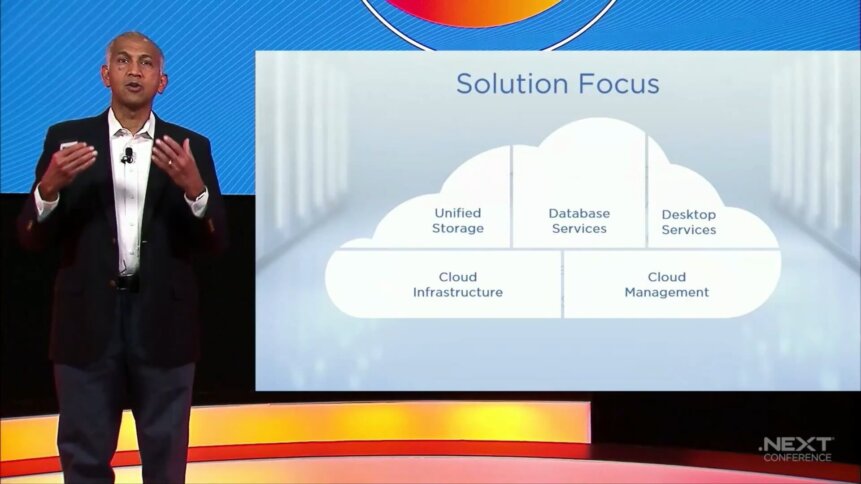Nutanix believes the hybrid multi-cloud is the dominant cloud strategy

While cloud adoption continues to see ramped-up adoption, Nutanix feels that businesses need to have optionality when consuming cloud services. One of the reasons for this was the rising costs accumulated in the long run from running workloads entirely on the public cloud.
Speaking at Nutanix’s .Next conference, Rajiv Ramaswami, the CEO of Nutanix pointed out that apart from costs — data governance, regulations as well as security expenditure are also among the reasons why there has been a slow down on businesses moving workloads to the public cloud.
The virtual conference saw speakers from various organizations share their cloud journey experiences. During the opening keynote, Ramaswami highlighted what Martin Casado, General Partner at Andreesen Horowitz, calls the trillion-dollar paradox. For Casado, while the cloud is significant, it has cost billions of dollars of IT spend. As the industry experience with cloud matures, Casado believes it is becoming evident that “while cloud clearly delivers on its promise early on in a company’s journey, the pressure it puts on margins can start to outweigh the benefits, as a company scales and growth slows.”
Elaborating further, Casado said that there is growing awareness of the long-term cost implications of the cloud. For some businesses, steps have been taken in repatriating a majority of workloads or adopting a straight hybrid cloud approach — especially as the costs of public cloud takeup start to contribute significant hits to the bottom line.
In fact, Casado said that businesses that have made the move to repatriate workloads from the public cloud have reported significant savings. “We are still trying to understand the implications of the cloud. We know the benefits. We are now entering an era where there is a lot of discussion on the right architecture of the cloud and how the cloud should be adopted,” declared Casado in his session at .Next.
Cloud on your terms with Nutanix
For businesses, understanding the true cost of cloud is something they hope they can understand before making any decisions on their cloud options. However, Ramaswami believes that optionality is critically important, no matter which cloud strategy businesses pick.
“Customers who started on-premise look to move to the cloud, which is why optionality is critically important. The cloud is not a location or a company. It’s an operating model you consume. However, you need to have optionality on how you consume it,” commented Ramaswami.
As such, more businesses are now looking at hybrid multi-cloud deployments as the dominant strategy going forward. And this is where Nutanix plans to delight its customers with a simple open hybrid multi-cloud software platform, with rich data services that can build, run, and manage any application.
“Our newly redesigned portfolio offers a single platform for the hybrid multi-cloud era. Whether your workloads are in a private cloud, a public cloud, or with managed service providers regardless of which app you use, be it databases, analytics and user computing, or any other app of your choice,” said Ramaswami.
The new capabilities will have five key solution focus to make it simpler for customers to leverages solutions to achieve their business outcomes. They are:
- Cloud infrastructure – to build the cloud
- Cloud management – to operate the cloud
- Unified storage – to manage all data, structured and unstructured
- Database service – to manage database on the multi-cloud
- Desktop service
The Nutanix Cloud Platform will deliver unstructured data tiering from on-premises to cloud, up to two times storage performance increase for database workloads and three times for big data workloads without requiring complex reconfiguration, as well as Nutanix Data Lens, a new unstructured data governance service.
In addition, database service Nutanix Era now delivers one-click storage scaling and rich role-based access control for database management across hybrid multi-cloud environments for database engines like PostgreSQL, MySQL, Microsoft SQL Server, and Oracle Database.
During the keynote address, Ramaswami also announced that Nutanix is joining forces with Citrix Systems to provide secure, on-demand, and elastic access to apps, desktops, and data from any device, in any location — at any scale — through Nutanix hyper-converged infrastructure and hybrid multi-cloud deployments of Citrix Desktop as a Service (DaaS) and Virtual Apps and Desktops services.
The true cost of cloud
For organizations, at the end of the day, it’s all about generating growth and income. While the public cloud does have cost implications in the long term, it’s also the cheapest transformation tool for most businesses.
Regulated industries and large enterprises would find the hybrid multi-cloud the best option for them and Nutanix themselves have created a platform capable of delivering the best outcomes for these companies without adding more complexities for them.
There is no denying that more data governance policies, regulations, security, and costs will have an impact on which business will find the public cloud the better option. But as Ramaswami puts it, having the options may just allow businesses to have some chance to make some changes in the future if they need to.










